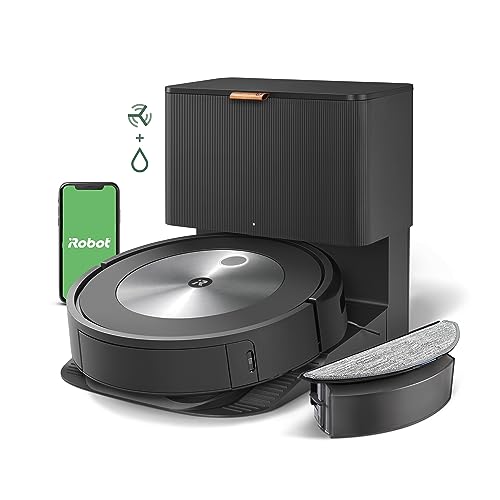5 Self Emptying Robot Vacuum Projects For Any Budget
페이지 정보
작성자 Genevieve 작성일24-03-17 20:36 조회5회 댓글0건본문
 The Convenience of a Self Emptying Robot Vacuum
The Convenience of a Self Emptying Robot VacuumA robot vacuum that self-empties stores debris in a massive storage bin within its docking station, instead of releasing them out into the air. This is an enormous benefit for those with allergies.
If you live in a big home, you should consider a model with a long running time and a big dustbin that can return to its original location to recharge between cleaning sessions. It is also advisable to consider app integration that lets you set no-go zones as well as adjust settings like suction power.
1. Less Irritating
One of the biggest disadvantages of the regular robotic vacuums is that they often have tiny dustbins that need manual emptying after each couple of cleaning sessions. This can be a hassle, especially if you have someone living in your home who suffers from allergies. The process of emptying a small dustbin usually results in a haze of noxious debris being thrown into the air. This issue can be solved with self-emptying robots that automatically empty their collection bins into a larger container. This brings the glorious idea of a fully automated household closer to the reality.
Generally speaking, jcorporation.kr self-emptying robots use a special dock that is not only charged but also connects to a series of vacuums which pull dirt and debris from the collection container and place it in a large bin. When the canister is empty the device will return to its dock and empty its contents. Then it'll move to a new location in the house to get it cleaned. This is less stressful than emptying your onboard dustbin and is easier to do because you won't breathe the debris as it is released into the air.
The downside to the self-emptying system is that it adds to the price of a robot vacuum. It's important to remember this when choosing the right model for your requirements. You'll want to make sure that the canister is big enough to accommodate your home's size and desired cleaning frequency.
Self-emptying robots aren't for everyone. But they can be a great choice for those suffering from allergies or busy families who don't wish to spend time emptying their dustbins. It's a great solution for those who have large houses that are too large to be covered by a single robot vacuum with self empty.
A lot of self-emptying robotics are designed to make your life easier. They have features such as app control scheduling, mapping technology, scheduling mop/vacuum switch functions and much more. They can be connected to your Wi Fi and smart home devices that allow you to control them even when you aren't at home.
2. Less Wastage
 They can be useful however they must be maintained regularly. They can also get caught in random objects like shoeslaces that aren't tied as well as phone chargers and pet toys, or even snagged on the thresholds of doors and thick rug.
They can be useful however they must be maintained regularly. They can also get caught in random objects like shoeslaces that aren't tied as well as phone chargers and pet toys, or even snagged on the thresholds of doors and thick rug.Self-emptying models provide a solution to the problem of the dust bin with the tiny robot vacuums. These vacuums return to their base automatically once the canister is full. They empty the dirty debris into a high-height bin that contains a disposable paper bag. The vac will then return to its cleaning routine that is pre-programmed.
Most of these models are able to detect when their batteries are running low, too. They can then pause the cleaning process and return to the base to recharge, then resume the cleaning process when the battery is fully charged. If you're looking for more convenience, opt for one that can be scheduled at specific times (such as every three months) to drain itself.
These models are more expensive than standard robot vacuums but they're worth the investment for some homes, especially for people with respiratory allergies or other respiratory ailments. These models are designed to capture more dust hair, pet hair and other allergens than conventional vacuums. They can reduce the symptoms of allergies.
The latest robot vacuums utilize sophisticated technology to map your entire home prior to every cleaning session. This makes them more efficient than earlier models. They can also designate "no go" zones that stay clear of certain areas like a rug or a toy for children. Some allow you to schedule cleaning times each day, every week or during your absence. Some come with the ability to control the remote and have voice assistants for additional convenience. They're ideal for busy households who would benefit from an easier, healthier living space without having to spend lots of time doing the chores.
3. A Shorter Time
Self-emptying robot vacuums take one of the biggest time consuming steps out of the process. These models automatically transfer debris out of their onboard bins to a larger bin at their base station when they find it full. This reduces the need to stop cleaning sessions in order to empty the bin, and makes them a lot less of a hassle for busy people, especially those with mobility issues.
To test the capability of a self-emptying robot to transfer debris from its onboard dustbin to its base and back to the charging base, we added a weighed amount of dry debris to the robot's onboard dustbin and measured the percentage that landed in the receptacle for charging docks. Models that transferred a higher proportion of the dry debris that was weighed to the charging base dustbin or bag earned a higher score in our tests.
This is particularly beneficial for busy families and people who have mobility issues, as it can eliminate the need to stop cleaning to open and empty the dust bin that is built into the robot. If you'd like to keep track of your robot's progress, some models can be connected to voice assistants like Alexa or Google Home so that you can control them with a few simple commands. You can also set up no-go zones and check the robot's performance. You can also alter settings and schedule cleaning sessions.
While a self-emptying vacuum is simpler to use, it is louder than conventional vacuums. This is an important factor to consider if you are sensitive to sounds. If you're worried about noise levels, look for a machine that has an 'In-Situ' Mode or plan your cleaning times to be done when you're away from the home.
These robots are easier to operate, which is a benefit. This allows you to make use of them more often and keeps your floors in good condition for longer.
4. Less Money
As a convenience feature Self-emptying robot vacuum can add functionality and value to compatible robot vac models. It makes it less necessary for you to empty the dustbin on your robot which can be time-consuming and messy. It makes it easier to utilize a robot vacuum in larger spaces, where you may have to use it more frequently.
Self-emptying robots are generally a bit more expensive than other types of robots. They cost more because they have a sophisticated system to store and manage the dirt and waste that they gather. Some have an automatic hopper that disposes of the waste collected into a bin, but the capacity typically limited to around 2.5-3 litres. You'll only have empty the bin once every two or three cleaning cycles. This will save you time and effort over the life of the robot.
Self-emptying robots which are the most advanced can also generate a detailed home map, that lets you label different rooms and set up virtual no-go areas. Some models can be controlled by voice assistants like Alexa. They're not inexpensive, however, with the most expensive models costing more than $1000.
While a self-emptying robot vacuum takes some of the work out of cleaning, it's not foolproof. Even the most sophisticated robot vacuums can become stuck under furniture or on thick rugs, and be trapped by cords, phone chargers, and pet toys. If this happens, you may have to conduct an extensive inspection of the floor before letting your robot go. It might also give up and send you an SOS.
Another drawback of the self-emptying model is that it's a large and heavy unit. This makes it difficult for robots to fit into tight places. It takes up plenty of space on your kitchen table or coffee table counter, especially in the case of an external bin that has capacities of up to six litres.
댓글목록
등록된 댓글이 없습니다.





